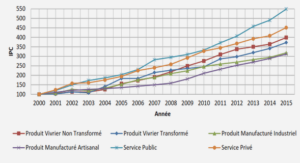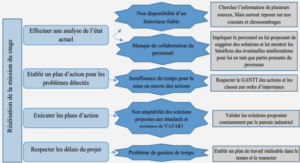The Genetic Algorithm
The Genetic Algorithm (GA) was invented by Holland (1975), and was based on Darwin’s theory of evolution. Researchers have worked intensively on hybrid GA and NN combinations since the late 1980s, utilizing the GA’s attributes to improve the design of NN methodologies. The GA is a robust optimizer that can be easily implemented to solve a large variety of complex problems, especially combinatorial problems. However, GAs do have certain limits; their efficiency is not as high as that of an algorithm specifically designed for a given problem; setting the control parameters is difficult and the quality of the results are sensitive to the population size and the rate of mutation/crossover (Ben Mosbah, 2011). Many complex problems have been solved using GA by “itself” or in “hybridization”. These algorithms have been used in software optimization (Asadi et al., 2010), manufacturing and scheduling optimization (Iyer and Saxena, 2004) (Rajkumar and Shahabudeen, 2009), flight trajectory optimization (Patrón et al., 2015), etc. The GA was used by Roudbari and Saghafi (2014) to optimize a NN system to improve the identification and modeling of aircraft nonlinear dynamics.
An optimization approach using GA was proposed by Lu et al. (2006) with the aim of designing and optimizing NNs. Their proposed methodology, called the GANN, was first applied to helicopter systems design. Lu et al. (2006) used the GA to determine the optimal structure and connection weight of the NN where it was very important to minimize the prediction error. They applied the GANN to estimate two parameters. The first parameter concerned the main rotor diameter determined from two known parameters, the maximum speed and the maximum weight. The second parameter was the main blade chord determined from the number of blades and the maximum weight. Another important research using a hybridization between GA and NNs was proposed by Hacioglu (2007). The objective of this research was to design an airfoil and to reduce the corresponding computational costs. Pehlivanoglu and Baysal (2010) proposed a methodology called the multi-frequency Vibrational Genetic Algorithm (mVGA) to determine “which” and “when” individuals should be mutated, as a means to increase the optimization algorithm speed. The mVGA was first coupled with a fuzzy logic algorithm and then further applied on an inverse design problem to determine the geometry of the airfoil that supported the resulting pressure distribution in subsonic flow conditions. Next, the mVGA was coupled with a NN algorithm, and further tested on an airfoil shaping optimization problem with the aim to increase the lift and decrease the drag. These two parameters, lift and drag, were then estimated using NNs. Many other applications of GAs were presented by Bigdeli et al. (2013) and Jin-peng et al. (2013).
Neural Networks in Wind Tunnel Applications To perform a good flight stability and aircraft performance analysis, it is necessary to control the flight parameters. The Artificial Intelligence (AI) methodology has been used extensively by researchers to identify and control flight parameters, including using identification models based on NNs and/or fuzzy logic. The computing time increases with the complexity of the approach, so that the main objective is to minimize the complexity of the methodology while keeping its accuracy in real time. AI techniques are usually coupled with optimization algorithms such as GA in order to obtain a very good learning process. Over the past two decades, these types of methods have been little used in wind tunnel tests. Researchers have recently begun to develop control methodologies that that can be experimentally tested and validated in a wind tunnel. Many problems in the Aeronautical industry have been solved using ANNs. Faller and Schreck (1996) presented a review in which several applications of ANNs were used to solve complex aeronautics problems. These include: a control law for aircraft high-performance proposed by Ha (1991), fault diagnostics to identify the structure damage (Hebert et al., 1993), an identification of aerodynamic coefficients (Linse and Stengel, 1993) and (Sajid et al., 1997), and an icing detection study proposed by Johnson and Rokhsaz (2001) and another by Rahmi et al. (2005). ANNs have been used and validated using WTTs.
In 2000, Abha et al. (2000) were among the first researchers who started to use neural networks methodologies in wind tunnels. They used this approach to design a model to predict the strain from the air speed and the angle of attack. Nine neurons distributed on three layers were used to define the proposed methodology. A wing mockup was manufactured from composite materials, and fiber optic sensors were installed on it to measure the strain during wind tunnel tests. The strain values given by sensors were used to train, and further to validate the neural network methodology. Following the comparison between the experimental and the predicted results, the proposed method gave very good results, as it gave an average error of less than 3.17% for the strain average values. In the same year, Scott (2000) used ANNs to design control systems that were further evaluated experimentally using WTTs. Three methods were proposed. The first method was used to schedule Single Input Single Output (SISO) control system parameters according to wind tunnel conditions (Mach number and dynamic pressure). The second method was used for a predictive control system to predict its future physical model response, and the third method was used in an inverse model to control the aeroelastic response in the wind tunnel (Scott, 2000).
Suresh et al. (2003) developed a prediction approach based on NNs to estimate the lift coefficients at high angle of attack (AoA). The proposed NN methodology was trained using experimental data collected via WTTs. The authors used two inputs to calculate the lift coefficients. The first input was the mean angle of attack AoAmean, and the second was the angle of attack, varying from AoAmean with ±6o. The NN approach they propose has shown a good performance; the error between the experimental and the predicted lift coefficient was lower than 1%. The computing time of this NN approach was very low, allowing this approach to be integrated with any other commercially available code (Suresh et al., 2003). Haiping et al. (2007) reported on an important effort to improve the performance of a NN approach to detect flight parameters. They used multiple hot-film sensors for flow speed measurements. Their approach uses the flow speed to detect the angle of attack, the angle of sideslip and the air speed corresponding to the flow speed values. The numerical model analysis was validated by using wind tunnel tests, where the obtained results confirmed the efficiency of the proposed NN approach. The methodology proposed in this research can be quite useful to replace conventional mechanisms and techniques to measure the flight parameters. These mechanisms are usually mounted on an airplane, and generally they are too massive for unmanned aircraft vehicles (UAVs) (Haiping et al., 2007).
These NN models could thus improve the performance of UAVs. A method to estimate the stability derivatives of an HFB-320 aircraft was proposed by Peyada and Ghosh (2009). This approach was based on a combination of the ANN and Gauss-Newton methods, and was validated using flight data. Samy et al. (2010) proposed an ANN methodology to estimate the angle of attack, the freestream static pressure and the freestream airspeed. This approach was designed for reduced-scale Unmanned Aerial Vehicles (UAVs). The objective was to replace conventional estimation techniques used for large-scale aircraft, as they cannot be used on reduced-scale UAVs due to their weight. Using the ANN approach, the weight of the instrumentation was reduced by 80%, while its cost was reduced by 97%. Ruiyi and Rong (2012) designed a back-propagation neural network methodology to calculate the aerodynamic parameters of reduced-scale aircrafts. Their NN methodology was used to model the coupling between readings of micro-hot film flow sensors and aerodynamic parameters to deduce the air speeds, the angles of attack and the angles of sideslip (Ruiyi and Rong, 2012). Validated using WTTs, this method uses miniature sensors installed on an aircraft wing, replacing conventional sensors that cannot not be installed on UAVs. The modeling of nonlinear unsteady aerodynamic coefficients was performed by Ignatyev and Khrabrov (2015), and was further validated by WTTs. Two ANN architectures were used, one with a recurrent NN and one with a feed-forward NN architecture. These two architectures can describe the nonlinear phenomena during oscillation tests, with the aim of developing pitching moment coefficients.
Support Vector Machines Support Vector Machines (SVMs) can be applied to solve both regression problems and classification problems. The optimization we are solving involves regression problems. The SVM methodology offers very good performance in non-linear modeling and has thus gained broad popularity. The difference between the NN and the SVM methodologies is based on the principle of error minimization. NNs execute error minimization for its training data, while the SVM tends to create an upper limit of the error (Lahiri and Ghanta 2008). Huiyuan et al. (2004) used the SVM approach for aerodynamic modeling. They applied SVMs to aerodynamic model data to examine the feasibility of its application in this field. The utilized three SVMs: one for the performance prediction of a prototypic mixer for engine combustors, and two to calibrate the total pressure coefficients of selected hole pressure probes. The results obtained with the SVM methodologies were compared to those obtained from the NN methodologies, and with those given by the CFD code. The SVMs demonstrated their superiority over the NN methodologies (Huiyuan et al. 2004). An interesting approach to optimizing inflatable wing design parameters was proposed by Wang and Wang (2012) . Their proposed methodology is based on orthogonal testing and SVMs. Both high accuracy and a highly efficient (minimal) computation time were obtained. Another methodology utilizing SVMs was recently developed for unsteady aerodynamic modeling at high angles of attack (Wang et al., 2015). This methodology was designed, trained, implemented and validated based on WTTs data. This and other studies have shown that SVMs have a very good learning capacity and ability to predict aerodynamic coefficients. SVMs have been hybridized as a means to optimize them with improved parameters to obtain better results. In one of these studies, Üstün et al. (2005) used a GA to design an optimal SVM methodology. This optimization was done to improve the predicted results as well as to reduce the computing time. Samadzadegan et al. (2012) determined the SVM parameters required for the classification of hyperspectral imagery using an Ant Colony algorithm to optimize the SVM methodologies. The results obtained by this hybridization were compared to four other hybridizations of SVMs and metaheuristic algorithms. The Ant Colony algorithm gave a lower computational cost than the grid search, simulated annealing, tabu search and GA algorithms.
|
Table des matières
INTRODUCTION
CHAPTER 1 LITTERATURE REVIEW
1.1 Hybrid Approaches
1.1.1 Neural Networks and Fuzzy Logic
1.1.2 Artificial intelligence and optimization algorithms
1.1.2.1 The Simulated Annealing
1.1.2.2 The Genetic Algorithm
1.2 Neural Networks in Wind Tunnel Applications
1.3 Support Vector Machines
CHAPTER 2 APPROACH AND THESIS ORGANIZATION
2.1 Thesis Research Approach
2.2 Thesis Organization
2.2.1 First journal paper
2.2.2 Second journal paper
2.2.3 Third journal paper
2.2.4 Fourth journal paper
CHAPTER 3 ARTICLE 1: NEW METHODOLOGY FOR WIND TUNNEL CALIBRATION USING NEURAL NETWORKS-EGD APPROACH
3.1 Introduction
3.2 Subsonic wind tunnel
3.3 Flow characterisation
3.3.1 The Log-Tchebycheff Method
3.4 Extended great deluge technique
3.5 Neural network approach
3.5.1 Implementation of neural networks and Preliminary results
3.6 Conclusion
CHAPTER 4 ARTICLE 2: A HYBRID ORIGINAL APPROACH FOR PREDICTION OF THE AERODYNAMIC COEFFICIENTS OF AN ATR-42 SCALED WING MODEL
4.1 Introduction
4.2 Support vector machines (SVM)
4.3 Optimization of the SVM parameters
4.4 Extended great deluge algorithm
4.5 New proposed SVM-EGD algorithm
4.6 Infrastructure
4.6.1 Price-Païdoussis wind tunnel
4.6.2 Transducer
4.6.3 ATR-42 wing
4.7 Implementation of the SVM-EGD algorithm and analysis of results
4.7.1 Theoretical results
4.7.2 Experimental results
4.8 Conclusions
CHAPTER 5 ARTICLE 3: NEW METHODOLOGY COMBINING NEURAL NETWORK AND EXTENDED GREAT DELUGE ALGORITHMS FOR THE ATR-42 WING AERODYNAMICS ANALYSIS
5.1 Introduction and background
5.2 Flight parameters
5.3 XFOIL code
5.4 Neural networks
5.5 EXTENDED GREAT DELUGE
5.6 NN-EGD ALGORITHM
5.7 Implementation of NN-EGD and theoretical results
5.7.1 The CL, CD and CM prediction system
5.7.2 The Cp prediction system
5.8 Experimental tests
5.8.1 Equipment
5.9 Experimental results
5.10 Conclusion
CHAPTER 6 ARTICLE 4: A NEURAL NETWORK CONTROLLER FOR ATR-42 MORPHING WING ACTUATION
6.1 Introduction
6.2 ATR-42 Morphing Wing Model
6.3 The closed loop architecture of the model
6.3.1 Controller architecture
6.3.2 Modeling of the DC motor
6.4 Neural Network Control System Design
6.5 Experimental work
6.5.1 Concept of the experimental work
6.5.2 Experimentation and real time validation
6.5.2.1 Hardware
6.5.2.2 Real-Time Model
6.5.2.3 Validation Results
6.5.3 Wind tunnel test
6.5.3.1 Experimental test equipment
6.5.3.2 Experimental results
6.6 Conclusion
DISCUSSION OF RESULTS
CONCLUSION AND RECOMMENDATIONS
LIST OF REFERENCES
![]() Télécharger le rapport complet
Télécharger le rapport complet




